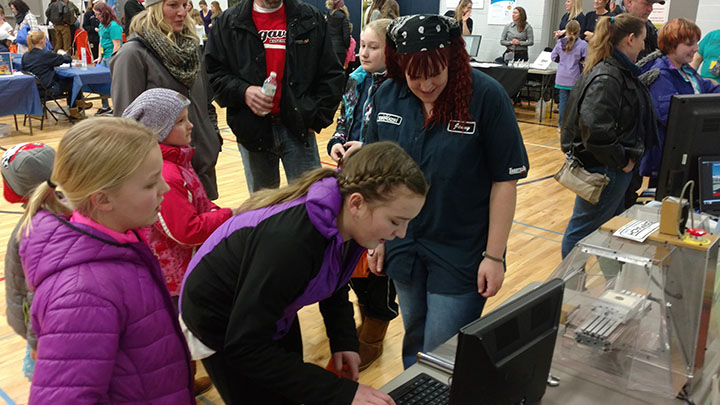I love STEM events. Students huddling around chemistry experiments, buzzing machines, and the buzzing of learning makes me giddy; all of these bright young minds are going to be our future, and, with our help, our legacy as STEM professionals.
The most recent event I got to check out was in Hudson, WI, my home prior to moving to Waunakee to work at at Tormach. This is the first year they’ve let the boys come, since the event’s primary goal is to encourage girls to pursue STEM, but guys said they wanted to join in on the fun.

Northern Wisconsin is unique in that the STEM community is incredibly united, providing a great example of what to do for success. If you’re school or community organization looking to put together an inspiring event like this, here’s what you need to know:
Connect with Everyone in Town
What makes STEM events successful is including everyone in town, from the local building contractors to the DNR agent to a manufacturer. This way students can see all the different STEM-related careers in their community and put faces to jobs they’ve heard about.
When kids hear I’m a machinist while we’re watching some chips fly, their eyes get wide as they say ‘my dad’s a machinist’, because it suddenly clicks in their head exactly what their dad does at work. It also means they get to see the diverse workforce in their area.
Send Out Event Information Early – But Not Too Early
I’ve shown up to an event with a couple-days’ notice (luckily a babysitter was available), but I would have been more prepared with more time. Three months is perfect for me when it comes to preparing for a show, so I can get all the giveaways ready, a machine reserved for travel, and all the other travel arrangements made. If you give too much notice, it might get pushed aside, or the technology and information may become dated.
Reserve a Big Space with Lots of Power
What makes STEM careers interesting is all the toys you get to play with – machines, microscopes, computers, and the list continues. These all require power, so make sure your facility has lots of power strips, space, and internet available so we can properly show off all the cool things we do. Some people will bring spares, but we all end up sparring for that last socket.
Tell Businesses What to Be Prepared For
Most times, presenters like myself get the general ‘come to the event’ email, but we’re not told much more. Make sure you tell us what type of space is available, if Wi-Fi is available, what type and the age of the crowd you expect, if you’re doing swag bags so we can contribute, and all of those smaller event details. One way to do this is to share a potential packing list to the companies, which could include: business cards, a TV to play video, pamphlets, an interactive activity, and some type of swag.

Make It Interactive
Kids sit in class all day, so this is a great opportunity to get them some hands-on experience with STEM. I always talk them through engraving on a machine so they can walk away with something, like a book mark or keychain, and the pride of knowing it was something they made. Others have done similar things; I’ve seen a chemistry professor having students do experiments, engineers hosting structure building competitions, and a veterinarian with some animal guests for students to meet.
Another idea is to make meeting the presenters a game. Some schools do passports, where students have to go around the all the booths and get a stamp so they could be entered in a drawing. Another school made all the presenters baseball trading cards with their picture and career description on them. This is a great take-away for the kids, but it does require some planning and information from the presenters.
Invite the Parents
Getting kids excited about a career in STEM is the first step, but parents foster that excitement and passion, so sharing it with them is equally important. One great example I’ve seen is an event partnered with local businesses and colleges, so if parents had questions about what STEM training programs looked like, they could ask the professors and instructors.
If you have any other ideas of how to make a STEM event successful, I’d love to hear them. Comment below or contact me at jen@tormach.com.


